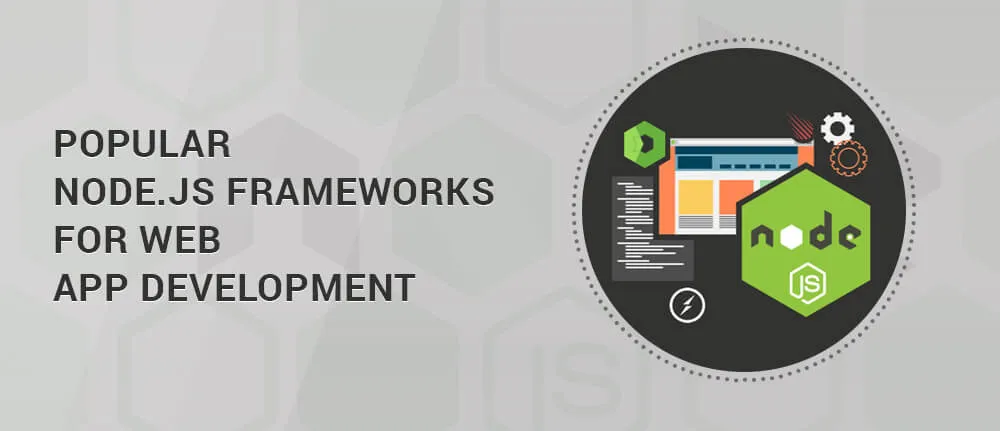Seven Ways CRM Software Can Help Reduce Costs for Your Business
CRM is an all-in-one tool that can help in pushing your business to new limits. Moreover, a CRM system can streamline management and also help in reducing costs. Surprisingly,...
Listening is fun too.
Straighten your back and cherish with coffee - PLAY !

Web and mobile trend has made JavaScript as preferred front-end web programing language among software development companies. The new entrant, node.js, in the market has broken the common concept of using JavaScript just for front-end. Node.js is becoming popular and preferred server-side scripting language for mobile app, front-end, system apps and databases. Node.js is lightweight and provides basic functionalities to webserver that boosts application development speed. There are so many frameworks available in NPM package library that can be used for node.js web development that can help node.js web development companies to boost the web development turnaround time.
We would discuss and explore four popular Node.js frameworks widely used by node.js web development companies namely Express, Koa, Meteor and Sails.js.
Express is very popular Node.js framework that many frond-end developers prefer to use.
Many front-end developer respect node.js for speed. express provides basic routing, middleware, template engine and static files serving to node.js web application. As Express is minimal, Node.js software companies, can develop web application with own preference and no unnecessary new skills without MVC, MVP, MVVM.
Express has awesome feature of generator that generates specific project folder structure. To install express-generator from npm package, one can run
npm install express-generator -g
After installing express-generator from npm package and creating application skeleton using generator command
express helloworld
, will create folder structure with front-end static JavaScript, stylesheet files and HTML template files.
Middleware are functions that have access to both request and response. middleware does some common tasks like checking login status, validating authority, or preventing XSS.
Template engines allow Node.js software companies to add backend variables into HTML files, and when requested the template file will be rendered to plain HTML format.
create example.js with following code to run first Hello World
const express = require('express')
const app = express()
app.get('/', function (req, res) {
res.send('Hello World!')
})
app.listen(3000, function () {
console.log('Hello World app listening on port 3000!')
})
Now run node example.js
load http://localhost:3000/ in a browser to see the output.
As node.js is a minimal framework, it does have database integration within its package. But we can use particular data storage technology like MySQL, MongoDB, PostgreSQL, Redis etx with it.
The designer of Koa is the same as express.js., their goal was to minimize express by not bundling any middleware in it. Without middleware, Koa is very similar to express. However, Koa stands completely different by its ES6 generato
Node.js is basically JavaScript and JavaScript is asynchronous programming language, so in asynchronous programming callback is infamous hell. One way to settle callback nesting is to use Async.js. Now ES6 brings a game changer — ES6 Generator, ES6 Generator introduces a means to run->halt and run something else->come back to finish what is leftover.
Koa makes realistic use of ES6 generators to give simple way to manage JavaScript asynchronous programming so you can't see callback in pure Koa app. One symbolic use of ES6 Generator in Koa is middleware cascading,
var app = koa();
function* responseTimeLogger(next){
var start = new Date;
yield next;
var ms = new Date - start;
console.log(this.method + ' ' + this.url + ': ' + ms);
}
app.use(responseTimeLogger);
// ...
app.listen(3000);
Koa is difficult to debug and troubleshoot due to its unconventional control flow sequence.
Meteor is an all-in-one JS framework. It is different from express and Koa's Minimalist nature, it becomes huge by defining it full-stack framework package that contains server, mobile, desktop and web apps.
If you look closely in Meteor, you will notice that meteor is a combo of Node.js+Blaze/AngularJS/React+Cordova+MongoDB. where Node.js and MongoDB are responsible for server side logics and Blaze, AngularJS, and ReactJS for client side html output, Cordova is for hybrid mobile apps, bridges web pages to mobile views.
Following is the main process describing front-end and backend data share.
Client requests data or HTML view
Server gets data from database and sends it back to the front-end
Client shows the data/view in a user-friendly way
Data management mechanism with server and front-end/mobile apps is the feature that sets Meteor separate from other frameworks.
In Meteor, the client has a mini-database replica copy which is a small portion of server database. This mini-database is previously retrieved by client and authorized by server. When client make any change, it uses database api to perform CRUD, this data change automatically saves and sends to the server. Meteor use websocket so any change in data shows instantly at the other end.
So, meteor is highly automated framework which make developers’ life easier :)
Sails.js has many similarities with Express. it is a generator, middleware and templating engine.
Sails.js receives Model-View-Controller design pattern from its core Ruby on Rails or Laravel. Where Model represents data model, View is HTML view with filled data, Controller contains server-side business logic.
In HTTP request, client has to query for server data every time. but sails.js use socket.io to establishes a bi-directional communication between server and client. So sails.js is more suitable for chat app and multiplayer games
Sails.js provides a faster development compared to Express without losing any performance or future scalability.

CRM is an all-in-one tool that can help in pushing your business to new limits. Moreover, a CRM system can streamline management and also help in reducing costs. Surprisingly,...

CRM (Customer Relationship Management) has become an indispensable need for every business to connect, engage, and build relationships with customers. Rapid technology advancements...

One of the major alternatives that make any business reach the peaks is CRM i.e., Customer Relationship Management. It stands as a zone of successful business activities. CRM has become...